Biology sequence analysis, at the intersection of biology and computational sciences, represents a cornerstone in the exploration of genetic information encapsulated in DNA, RNA, and proteins. Emerging in the late 1960s and early 1970s, this field gained prominence with groundbreaking work on tRNA sequence analysis. The transformative moment came with the advent of the Basic Local Alignment Search Tool (BLAST) in 1990, which revolutionized the study of biological sequences and paved the way for subsequent breakthroughs. The field’s full potential was showcased during monumental projects like the Human Genome Project, where computational methods were indispensable for decoding the intricacies of the human genome.
Biological sequence analysis relies on a diverse toolkit of algorithms and tools sourced from bioinformatics databases and computational models. Foundational tools such as BLAST and FASTA facilitate sequence comparison and alignment, while advanced methodologies like phylogenetic tree construction, genetic algorithms, Markov chains, and dynamic programming (e.g., Smith-Waterman, Needleman-Wunsch) enable researchers to explore evolutionary relationships. Scoring matrices like PAM and BLOSUM, Bayesian alignment algorithms, and progressive alignment models (e.g., ClustalW, Gibbs Sampler) enrich the analytical repertoire, empowering researchers to glean meaningful insights from biological data.
The impacts of biological sequence analysis are far-reaching, influencing realms such as medicine, evolutionary biology, and biotechnology. Computational approaches have facilitated the development of targeted therapies for genetic disorders, deepened our understanding of species evolution, and propelled advancements in personalized medicine. As the field continues to evolve, the integration of cutting-edge technologies like artificial intelligence and machine learning promises to unlock new dimensions in understanding biological sequences. These innovative approaches hold the potential to drive transformative discoveries across scientific disciplines, opening avenues for novel insights and applications in the intricate tapestry of life sciences.
There have been a number of works in this field, including:
1. RNA structure analysis and prediction
2. Comparison of sequences
3. Global and local sequence alignment
4. Improving database searching by sequence
5. Multiple-sequence alignment
6. Pattern and profile methods of identifying distant homologs
7. Genomic analysis
8. Protein structure prediction
Reference:
- Briefings in Bioinformatics, Volume 20, Issue 4, July 2019, Pages 1280–1294, “BioSeq-Analysis: a platform for DNA, RNA and protein sequence analysis based on machine learning approaches “https://doi.org/10.1093/bib/bbx165
- R., Sean. E, Krogh A., G. M. (1998) Biological Sequence Analysis: Probabilistic Models of Proteins and Nucleic Acids. illustrate. Edited by R. Durbin. Cambridge University Press, 1998. Available at:https://books.google.com/books?id=R5P2GlJvigQC


